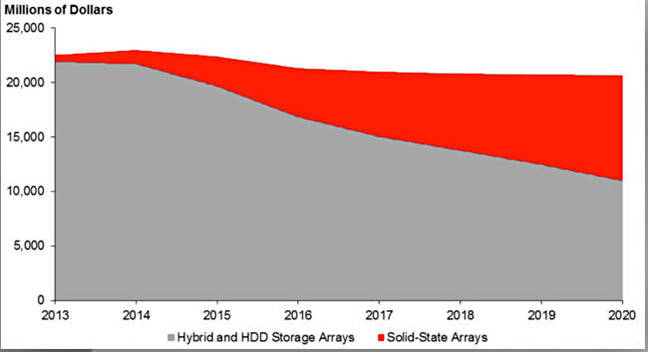This article is more than 1 year old
Flash reaches the enterprise tipping point
Mass enterprise performance array migration has started
Customer confidence
The AFA pioneers have been proved to be right, and sales of such arrays are growing, with IDC recording an 87 per cent year-on-year revenue growth rate. There is a long way to go, as AFA revenue amounts to just 7 per cent of enterprise storage system revenue, with IDC estimating that could be closer to 40 per cent by 2020.

IDC chart of all-flash array take-up 2013 - 2010
Compared to average disk drive arrays, AFAs can provide, according to Fujitsu, ten times lower power consumption, up to 500 times lower latency, five times more IOPS and up to 80 per cent lower maintenance costs. Drive failure rebuilds are five times faster. AFAs occupy less space than HDD arrays for the same performance, they need less cooling, and all of this affects and lowers their operational cost.
With Eternus AF arrays, quality of service can be guaranteed, on an application basis, with no fresh-out-of-the box performance drop-off or resource-hogging applications nullifying performance claims. Array operation can be automated with no need for manual tuning to get the best performance and storage costs from various storage tiers.
Instead of having separate physical storage tiers for varying levels of performance the array is, as it were, separated into virtual performance tiers and self-monitors to ensure applications get the quality of service they need and are entitled to. Deduplication and compression can be selectively applied to increase capacity for low response time and bulk data, but switched off for data that needs to be accessed as fast as possible.
Capacity
Disk drives developers have given up on increasing sheer data access speed. Spin speed reached 15,000rpm and then stopped. Disk latency hasn’t changed much in years and flash has far lower latency. Until this year disks generally had the edge on SSDs in the capacity stakes, with 8, 10 and then 12TB disks being developed using helium-filling technology to cram more platters and heads inside a 3.5-inch drive enclosure.
But then Samsung developed its PM1633a SSD with a 15.36TB capacity, using 48-layer, 256Gbit, V-NAND TLC (3bits/cell) technology. And it has 64-layer product with 512Gbit chips. Put these in the PM1633a and we have 30.72TB SSD. Such extraordinary high capacities make a 4TB or 8TB SSD seem normal, ordinary, and obviously acceptable, and give confidence in SSD technology generally.
Even Seagate, the arch disk drive supplier, has developed a 60TB SSD by cramming flash chips inside a 3.5-inch SSD case.
Modern flash arrays, like the Eternus AF250 and AF650 come in cost-optimised, entry-level (AF250) form and scalable and faster mid-range to high-end form. The AF650 scales from 2 to 96 drives and these drives themselves scale from 400GB to a planned near-16TB (TLC flash), meaning a capacity range of 800Gb right up to 1.5PB.
With deduplication the effective capacity can reach almost 7.7PB. Such a range and high capacity would need multiple racks of disk drives.
There is a realistic expectation that SSD capacities can double, and then improve again as 3D layering counts increase.
With these arrays able to be clustered then we have both scale-out and scale-up possibilities.
Endurance and non-stopability
Such high capacities make it easier to over-provision and AAD with flash dies. A 4TB SSD may have a three year working life. Over-provision by 4TB and you get a six year life.
No business is going to run mission-critical applications using storage hardware that could fail and halt the applications. The AFA must be continuously operating, non-stop, for mission-critical app support.
Automated failover can provide the non-stop characteristic, and all-flash arrays such as Fujitsu's Eternus AF have that characteristic.
Take-away
All mainstream storage array vendors have adopted all-flash arrays for storing performance data; Dell-EMC, Fujitsu, HDS, HPE, and IBM. Newer hybrid array suppliers such as Nimble, Tegile and Tintri have adopted all-flash arrays.
AFA storage technology has become the new normal and is poised to pass a tipping point. The performance disk drive array will revert to capacity data storage. Fujitsu says it's possible to adopt AFA technology alongside disk array technology, with a common management and data service umbrella. It recommends that enterprise data centres should adopt an intent to be 100 per cent flash-based in performance data storage.
Malcom Gladwell's book The Tipping Point describes how little things can make a big difference.
The tipping point is that magic moment when an idea, trend, or social behavior crosses a threshold, tips, and spreads like wildfire.
Little flash chips are making a big difference in enterprise IT. The AFA tipping point is here and it's time to enjoy the benefits of passing it. ®
